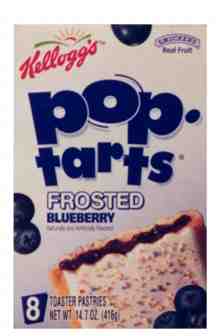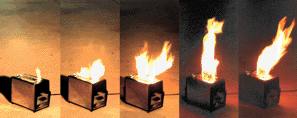|
The History of Pop-Tarts
In the beginning there was bread. Six thousand years
later, in 1919, the toaster was invented. People began enjoying toast. Forty years
after the invention of the toaster, Alas, the product was a failure. This was the Swinging '60s, baby. North American culture was on the move. You had to be "hip". It was all about space. You had to be groovy like a NASA astronaut. You had to wear silver. Your campus architecture had to look like it was about to leap off its foundations and launch itself into orbit. You couldn't be hip if you were eating something "square". And you certainly didn't power your go-go lifestyle with anything made by country folk. Country Squares? Oh, puhleeeez. Despite Post's failure, Kellogg's thought there was a huge
market for toaster pastry if it was properly and cleverly marketed. On Despite Kellogg's appeal to the counter culture, it played corporate hardball with grocers. First, Pop-Tarts was always plural (like "pants"). Second, Pop-Tarts were not to be stocked in the Cereals section. They could be stocked in the Baked Goods, Cookie, or the Cake Mix section. Are we clear? Pop-Tarts original four flavors were strawberry, blueberry, brown sugar cinnamon, and apple currant (bleck). Apple currant quickly faded into history, in lock step behind Beatle boots. Kellogg's released chocolate Pop-Tarts and eventually versions covered with frosting and sprinkles. Later Kellogg's tweeked the sprinkle recipe and introduced Stay-Shur Sprinkles which would not fall off and foul your toaster. Where other toaster foods have failed, like Downyflake Toaster Eggs, ReddiWip's Reddi Bacon, Toaster Chicken Patties, and Highliner's Toast-a-Bass, Pop-Tarts has remained over the last four decades a reliable comfort food and a needed late-night study break snack. The genius of Pop-Tarts is that in good times or bad, the product endures. At the end of the 20th century, Pop-Tarts sales spiked. Its high calories and long shelf life made it a perfect emergency ration for Y2K survivalist freaks. The threat of global economic collapse at the end of the 1990s and Pop-Tarts' looming place as not only a dietary staple but a potential universal currency along side timeless standards like gold and salt pork was no doubt welcomed by Kellogg's marketing droids. See, in the mid-'90s Pop-Tarts suffered some damaging press. It was scientifically demonstrated the suckers were highly flammable. You could turn your innocent toaster into a blow torch if you cooked Pop-Tarts beyond the recommended cooking time. Like many great scientific discoveries of the past (such
as the Law of Universal Gravitation and Post-It Notes), the infamous
"Pop-Tart Blow Torch Effect" was accidentally and unwittingly
discovered by Thomas Nangle of Dave Barry picked up on this spate of ill news developing in Springfield. He himself conducted his own Pop-Tarts experiment and produced similar results. After Barry's expose in his internationally syndicated column, much of the world was left in disbelief that a loved comfort food could be so dangerous. What next? Would we be told it is dangerous to use an aerosol can of Silly String around the open flames atop a birthday cake? Texas A&M professor Patrick Michaud, a leading authority in the emerging field of Food Entertainment, decided the world needed science to weigh in with an objective opinion. In a series of controlled experiments, Michaud discovered a standard off-the-snack-shelf Pop Tart can produce 18" high flames within 40 seconds of ignition.
Don't try this at home unless you're a recognized expert in the field of Food Entertainment With this mounting evidence, Nangle threatened to haul Kellogg's into court. Kellogg's settled out of court for $2,400. The dawn of the 21st Century and the saturation of computers has resulted in yet another market boost for Pop-Tarts. Where as fears of Y2K computer chaos made Pop-Tars popular with survivalists, the evolution of modern computer ergonomics has made it popular with the increasing number of computer and Internet users. And here we can invoke another technology developed during the space age that has benefited Kellogg's, namely the computer mouse. The mouse was developed by Xerox in the early '70s to enable children to use computers. Xerox's goal was to develop the hardware and software that would make computers accessible to school children. Xerox quickly discovered keyboards and the small clumsy hands of children are incompatible. So they developed the big, friendly mouse. Mice are now standard input devices and make it quite easy to surf the net or even get real work done with a single hand, leaving the other free hand to do something else, like satisfy a basic human need. You know, eating. The perfect breakfast food for harried mothers has now become the perfect breakfast food for harried office workers. It is the rare suburban commuter who has the luxury of time to enjoy a traditional morning repast. Unlike cereal, which is a decidedly two-handed operation (one hand scoops up the cereal and the other hand stabilizes the bowl, preventing the scooping action from moving the bowl alarmingly about the table), Pop-Tarts can be eaten with a single hand. -- Karl Mamer
|

